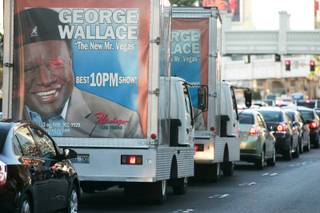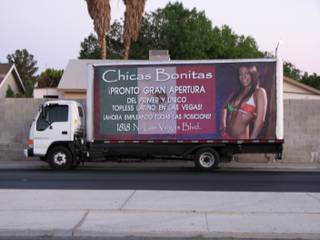Thursday, Sept. 24, 2009 | 2 a.m.
Sun Archives
- Las Vegas weighing regulation of mobile billboards (9-19-2009)
- How many walk the LV Strip? Mobile message deliverer now knows the answers (6-29-2009)
- Should they be banned? (3-27-2009)
- Billboards on trucks to face a review (4-8-2008)
- Jeff Simpson on why mobile billboards are worse than an eyesore (3-26-2006)
- LVCVA uses mobile billboards (8-23-2004)
- Deal on wheels: Vehicle owners earning income, glances with decorated rides (8-30-2001)
Eyesores on the Strip?

Viewing video requires the latest version of Adobe's Flash Player
For some, the scores of mobile billboards that troll the Strip are yet another reminder of the in-your-face advertising culture of Las Vegas.
The billboard trucks generally don’t operate within city limits, but some drivers have been planting them in residential neighborhoods during off hours. A proposed ordinance before the City Council would make that illegal.
The proposal illuminates the contrast and occasional conflict between living in Las Vegas and selling it — the racy resort corridor and the bland suburbs that are home to many who work in the resorts. It’s one thing to be constantly confronted with sales pitches while driving down the Strip, the ordinance is saying, but it’s quite another to be hit with them on your doorstep.
The measure, sponsored by Mayor Pro Tem Gary Reese, would prohibit mobile billboards from parking within 500 feet of a single-family dwelling.
Although it would impose some regulation on the largely unregulated industry, the ordinance isn’t intended as a frontal attack like Clark County Commissioner Chris Giunchigliani’s recent call for a complete ban. That’s not the city’s goal.
According to a city memo, “The bill is intended to help protect the quality of residential neighborhoods and is consistent with existing rules governing the parking of certain commercial vehicles in residential areas.”
One local mobile billboard company, Big Traffic Mobile Billboards, has a facility where its billboard trucks are stored when not in use. The company’s founder, Marla Letizia, says she couldn’t be more supportive of the city’s bill.
She said her company’s trucks are parked out of sight because she “knew that was the right thing to do” when she started the business eight years ago.
Her competitors that park their trucks wherever they wish are hurting the industry, she said. Letizia also wanted it made clear that her clients are reputable companies such as Harrah’s Entertainment and MGM Mirage, and not escort services.
Letizia said she heard about the proposed ordinance when she was contacted by Martin Dean Dupalo, a UNLV political science instructor and eastside neighborhood activist. Dupalo also contacted Reese to alert him to the problem.
Dupalo said he first became concerned when he saw a mobile billboard with an ad for an escort service in Spanish roll by his house.
Reese said the problem is particularly bad in neighborhoods near Lamb and Charleston boulevards.
“They should be driven around and not parked overnight where people live,” he said.
The billboards’ content is irrelevant, Reese added. Existing city laws regarding what vehicles can park in residential neighborhoods are being violated, and that’s enough.
When the operator of another mobile billboard outfit, Ofer Yablonsky, was asked whether his drivers were parking their trucks in residential areas, he said “never, never, no.” He declined to answer further questions.
Frank “Vince” Bartello, the manager of a third mobile billboard company, which is also one of the region’s largest “outcall service” operators for dancers and escorts, couldn’t be reached.
Mobile billboards are big business in Las Vegas. According to the Outdoor Advertising Association of America, such companies in Las Vegas earn $3 million to $5 million annually.
A recent study sponsored by Letizia’s company found billboards on the Strip are seen by thousands of tourists. On average, 17,700 people are walking on the Strip at any given hour on any given day, the study found. During the peak hour, from 8 to 9 p.m., there are about 40,000 people.
The Strip is, of course, the largest source of jobs in the area. Selling its attractions is key to the region’s economic survival.
The proposed mobile billboard ordinance illustrates that despite its importance, some residents don’t necessarily want the Strip to follow them home.



Join the Discussion:
Check this out for a full explanation of our conversion to the LiveFyre commenting system and instructions on how to sign up for an account.
Full comments policy